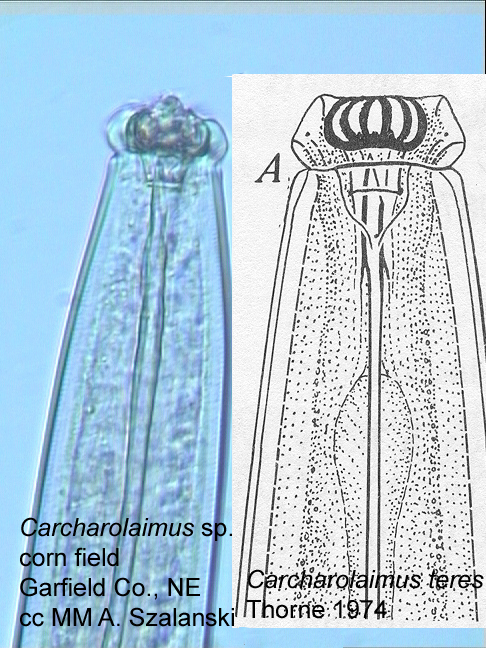
Photo Gallery Carcharolaimus teres Thorne 1939 This nematode was recovered from from corn fields located in Garfield County and Lancaster County, Nebraska. Other dorylaims from these fields include Aporcalaimellus, Eudorylaimus, Labronema,Laimydorus, Mesodorylaimus, Thonus, and Xiphinema. Trophic Group: Predator Maturity Index: 54
Family Carcharolaimidae, Thorne 1967 Subfamily Carcharolaiminae Thorne, 1967 Genus Carcharolaimus Thorne, 1939 Carcharolaimus teres Thorne, 1939 1.6 mm; a=37; b=4.2; c=65; V=104710 Body cylindroid, very slightly arcuate. Lateral fields 1/3 body width composed of conspicuous cells, each with a pore. Lip region set off by deep constriction with priminent papillae. Pharynx armed with a massive sclerotized, basket-like framework with jagged denticles in its base. Spear about 15u long, its aperture occupying ½ to 3/5 its length. Esophagus at first a slender non-muscular tube, suddenly expanded just anterior to middle. Basal portion cylindroid, filling body cavity. Cardia a thick disc followed by a convex conoid valve. Vulva with muscular labia, ovaries reflexed ½ distance back to vulva. Spermathecae not present nor were sperms present in the uterine tract. Males not collected in the Great Plains area. Among specimens from widely separated collections there are occasionally variations in the spear length, enlarged portion of the esophagus, neck length and tail shape which may vary from hemispheroid to conoid. Habitat: Both cultivated and virgin soil from southern
Colorado to Manitoba, Canada.
|